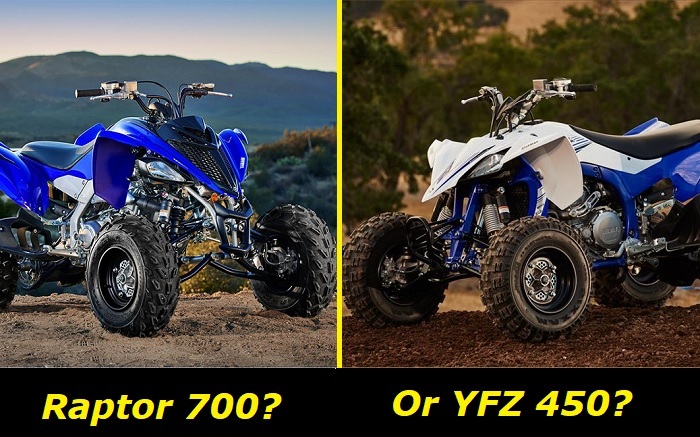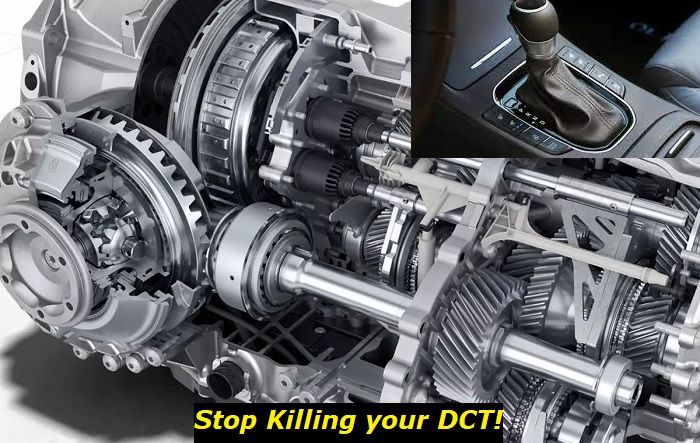Choosing between the Yamaha Raptor 700 and the Yamaha YFZ 450 all-terrain vehicles can be difficult. Both are popular ATVs, both have their pros and cons, and both are results of Yamaha’s decades of experience in making ATVs. But which one is more reliable? And which one has fewer reported problems from users?

In this article, we will compare the two models and try to answer those questions. As you scroll down, you will find this vital information that will help your decision-making:
- Key Specs of Each ATV
- Durability of Each Unit
- Common Problems Reported by Owners
Yamaha Raptor 700
- Key Specs
The 2022 Yamaha Raptor 700 retains the aggressive and sporty design of its preceding model with an emphasis on aerodynamics to deliver the best possible drag, handling, and overall performance that you need for racing. The unit is classified as a sport ATV, and it is defined by Yamaha’s most potent ATV engine.
The Raptor 700 has approximately 71 hp and 50 lb-ft of torque that will surely help you conquer rough, sticky, sloping, or wet terrains while keeping eye on the competition during racing. With its five-speed manual transmission plus reverse, you are free to take control of your pace in any given situation while the two-wheel-drive system with an X-ring chain ensures that you get the right traction that you need in your regular on-road or off-road rides.
All that power is thanks to its 686cc single overhead camshaft (SOHC), a four-stroke engine with four valves. It comes with a liquid cooling system and uses the 44 mm Yamaha Fuel Injection (YFI) for fuel delivery. It has a bore of 102 mm and stroke of 84 mm providing a compression ratio of 10.0:1.
With a top speed of 75 to 85 mph without the limiter, the Yamaha Raptor 700 is not just fast; it's one of the fastest stock ATVs out there. It can accelerate from 0-60 in six to seven seconds with ease. However, your experience may vary depending on terrain and other conditions which affect how quickly you go downhill or gain momentum when shifting gears.
Complementing the enormous engine output are hydraulic disc brakes with dual calipers in front and a single caliper at the back to provide you with enough stopping power when you need it most. It also includes an emergency brake lever that engages both sets of brakes for added safety and as a precautionary measure in case the primary braking system fails.
The Raptor 700 features a front independent double-wishbone suspension and swingarm rear suspension. Both sports adjustable piggyback shocks that give you leeway when choosing the right balance between performance and comfort. Then, it is fitted with lightweight 12-inch aluminum wheels hugged by all-terrain tires with sizes 22x7-10 and 20x10-9 for the front and rear, respectively. All that offers a maximum ground clearance of 9.5 inches, which gives you enough allowance when wading through shallow bodies of water.
After looking at the impressive numbers presented here and considering its 422 lbs. weight, you might expect this ATV to be a fuel-chugger. To break it to you, the Raptor 700 is actually fuel-efficient with an estimated consumption of 32 mpg in its 2.9-galon fuel tank. That would vary depending on your activities with it though, but that's the maximum you can get when doing a casual stroll.
- Durability
According to customer reviews, the Raptor 700 can last up to a decade if properly maintained. Some have reported getting up to 26,000 miles and even 30,000 miles from their units before requiring a major overhaul.
The Raptor 700 has been in production since 2006 and has only undergone gradual redesigns over the years just to keep its styling fresh and appropriate with the changing times. However, many of the components found all the way back to its 2006 model are still carried by the latest versions. Thus, the durability reviews are still relevant even in the current models.
- Common Problems
As impressive as it may sound, the Raptor 700 is not without its share of problems. Among the common issues most users complain about include the following:
- Stiffening shocks
- Quick wear of the front brakes
- Clogging fuel injectors
- Transmission slip
Should you end up encountering any of these after using your Raptor 700 for some time, be sure to have your ride checked and fixed by a mechanic right away to prevent the spread of the issue into the other sensitive moving parts of the vehicle.
Yamaha YFZ 450
- Key Specs
The Yamaha YFZ 450 only plays as a second fiddle to the Raptor 700 when it comes to power but that does not make it inferior in any way compared to other ATVs in the market. The moniker of the ATV traces its roots two years earlier than the current generation of the Raptor. Along the way, it bagged numerous awards and championships due to its overall design and performance.
The YFZ 450 has a smaller engine, featuring 449 cc displacement, liquid cooling, dual overhead camshaft (DOHC), five titanium valves, and a 42 mm electronic fuel injection. It has a bore of 95 mm, a stroke of 63.4 mm, and a compression ratio of 11.8:1. The better compression ratio of this unit compared to the Raptor 700 indicates better thermal efficiency.
The sports ATV does not shy away from the competition as it comes packing 53 hp and 33 lb-ft of torque distributed by a five-speed transmission to an O-ring chain final drive system. With that, it is capable of reaching a max speed of 75 mph without the limiter on and can do a 0-60 mph sprint in five to six seconds. That's surprisingly quicker than the Raptor 700 because the YFZ, despite sharing some key components with it, actually has a lighter frame that cuts its weight down to 405 lbs.
The YFZ 450 has the same hydraulic braking and suspension system as the Raptor 700 with only very minor modifications and adjustments. They do differ in tire sizes though, as this one uses all-terrain 21x7-10 and 20x10-9 for the front and rear, respectively. That's good for a max ground clearance of 9.3 inches, which is just 0.2 inches lower than the Raptor 700.
When it comes to fuel usage, the YFZ 450 is estimated to have the same fuel consumption of 32 mpg as the Raptor 700.
- Durability
Same as its bigger sibling, the lifespan of the YFZ 450 can be stretched up to a decade or 26,000 to 30,000 miles before requiring an engine overhaul and other major repairs. But then again, due to the lighter materials used in the YFZ 450, it has the tendency to wear out faster than the Raptor 700, especially when it is regularly used on tough terrains.
- Common Problems
Now, this is where the YFZ 450 strays away from the Raptor 700. That's because there are more complaints about it after years of use stemming from:
- Excessive vibrations in the engine and chassis
- Poor handling
- Transmission slip
- Loosening bolts in the suspension
- Quick wear of the wheel bearings
- Clicking noises due to worn bushings
- Dwindling fuel economy rating
- Engine bogging because of clogged filters, fuel injection problem, and faulty spark plugs
These are quite a handful compared to the common issues exhibited by the Raptor 700. Be sure not to dilly-dally when experiencing one or a combination of these problems, and call your mechanic right away. Have the worn parts replaced immediately to have your ride running smoothly again in no time.
Our Take
Both the Yamaha Raptor 700 and the YFZ 450 make excellent choices when it comes to sports-oriented ATVs. They come from Yamaha's long pedigree of success when it comes to quads so it's definitely hard to commit a mistake when choosing between them.
Despite carrying the reputation of Yamaha in their genetic makeup, there are certain things about each ATV that you should consider before finalizing your decision. With respect to the data presented here, we can arrive at the following conclusions and recommendations:
Raptor 700:
- Possesses 18 more horsepower and 17 lb-ft more torque than the YFZ 450. This is something that you should think of if you're in for better climb ability and you're looking for more power in tackling uneven terrains.
- Uses sturdier materials for its body making it more resistant to wear than the YFZ 450 with lighter components.
- Features a better ride quality because of its wider wheelbase.
- Has higher ground clearance so it is more capable of crossing over shallow bodies of water.
- Got generally higher positive reviews from owners and has lesser common complaints than the YFZ 450.
YFZ 450:
- Garnered many awards and racing championships over the years.
- Quicker than the Raptor 700 in sprints so this is advantageous if you are looking to spend more time on the race track or on the road rather than off-roading.
- Lighter and slightly smaller than the Raptor 700, which makes it easier to haul, store, and move around.
About the authors
The CarAraC research team is composed of seasoned auto mechanics and automotive industry professionals, including individuals with advanced degrees and certifications in their field. Our team members boast prestigious credentials, reflecting their extensive knowledge and skills. These qualifications include: IMI: Institute of the Motor Industry, ASE-Certified Master Automobile Technicians; Coventry University, Graduate of MA in Automotive Journalism; Politecnico di Torino, Italy, MS Automotive Engineering; Ss. Cyril and Methodius University in Skopje, Mechanical University in Skopje; TOC Automotive College; DHA Suffa University, Department of Mechanical Engineering






Add comment